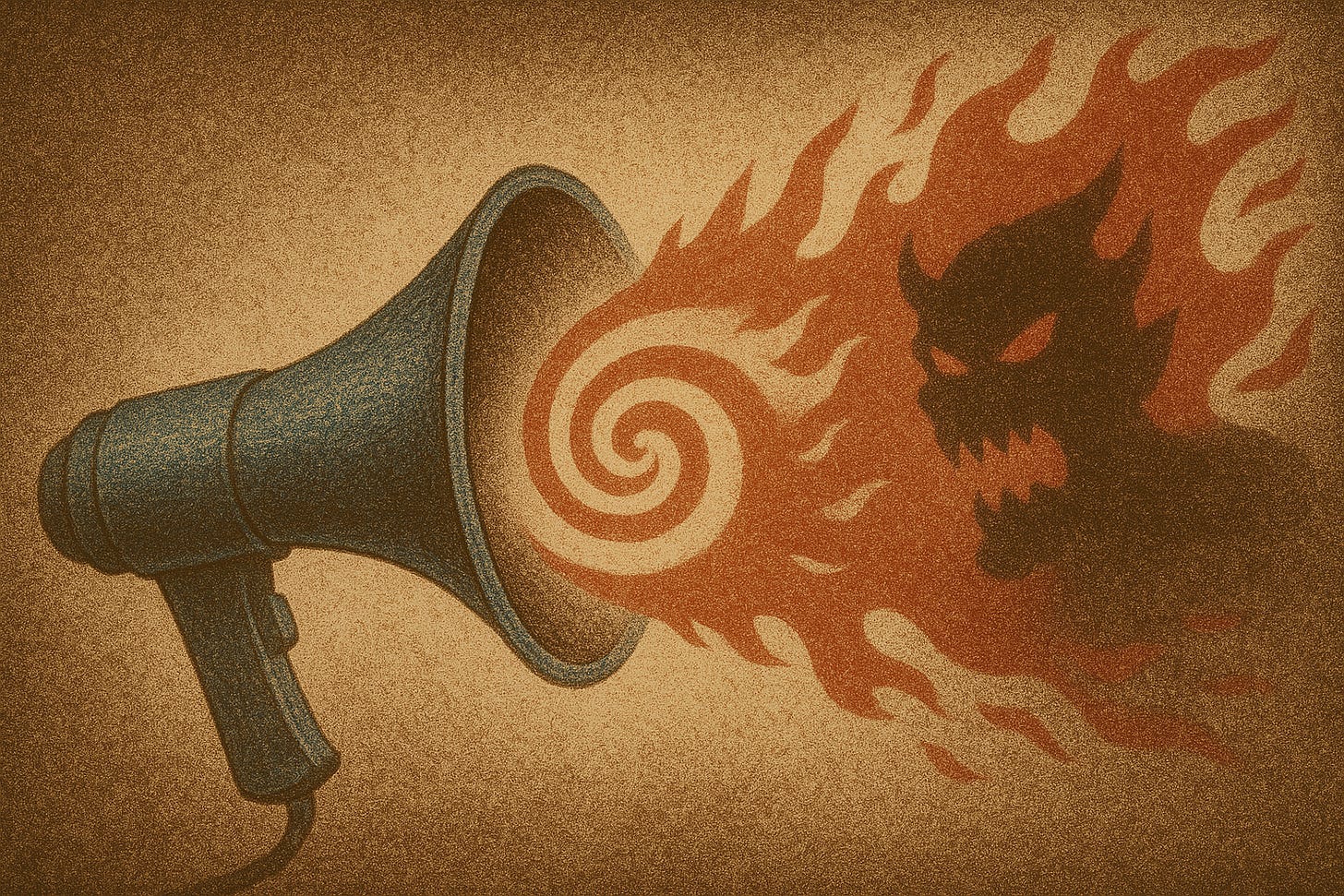Are There More Nazis Than Before?
Also: SF's breakthrough mayor and the rise of the multiracial right — #BCB 160
A few weeks ago, the Youtube channel Jubilee published a political debate video titled “1 Progressive vs. 20 Far-Right Conservatives.” At its peak moment, a participant proudly identified as a “fascist,” while another told the show’s guest, journalist Mehdi Hasan, to “get the hell out of this country.”
The video became viral — and so did the sense that we are surrounded by extremists.
But there are at least two kinds of selection bias here. First, of all of the dozens of hours of footage from all of the episodes of Jubilee’s “Surrounded,” this was the clip that went viral. Second, the show is deliberately designed as a debate between people with extreme views.
This isn't an accident. What Jubilee calls showcasing “the many versus the mighty” can also be understood as the death of the townhall and the birth of musical chairs for extremists. It's part of a broader shift in political media that's been decades in the making. Jon Stewart famously went on CNN’s “Crossfire” and warned Tucker Carlson that debate shows were “hurting America,” enraging rather than illuminating. Unfortunately, as we noted previously, Stewart then helped create the TV model that made political outrage profitable.
So how many Nazis are there, actually, and are there more than before?
The question immediately runs into the problem of definition. There has certainly been concept creep in the meaning of “Nazi” (no one alive is literally a Nazi). So let’s start with organized white nationalism. The best estimate we could find suggests that about 75,000-100,000 Americans actively participated in organized white nationalist groups in 2020. This is a lot of people, but it’s also just 0.02% of the population, two in ten thousand. Is this more than before?
We couldn’t find an estimate of how this number has changed over time. Instead, there are a number of related data sets that might plausibly include “fascists.”
At first glance, the Southern Poverty Law Center’s count of “extremist” organizations seems to show a sharp rise in the number of groups (not the number of people). However, this is because they changed their definition in 2021, including both “hate” and “anti-government” groups in the same count. The trend looked flat or perhaps decreasing before that.
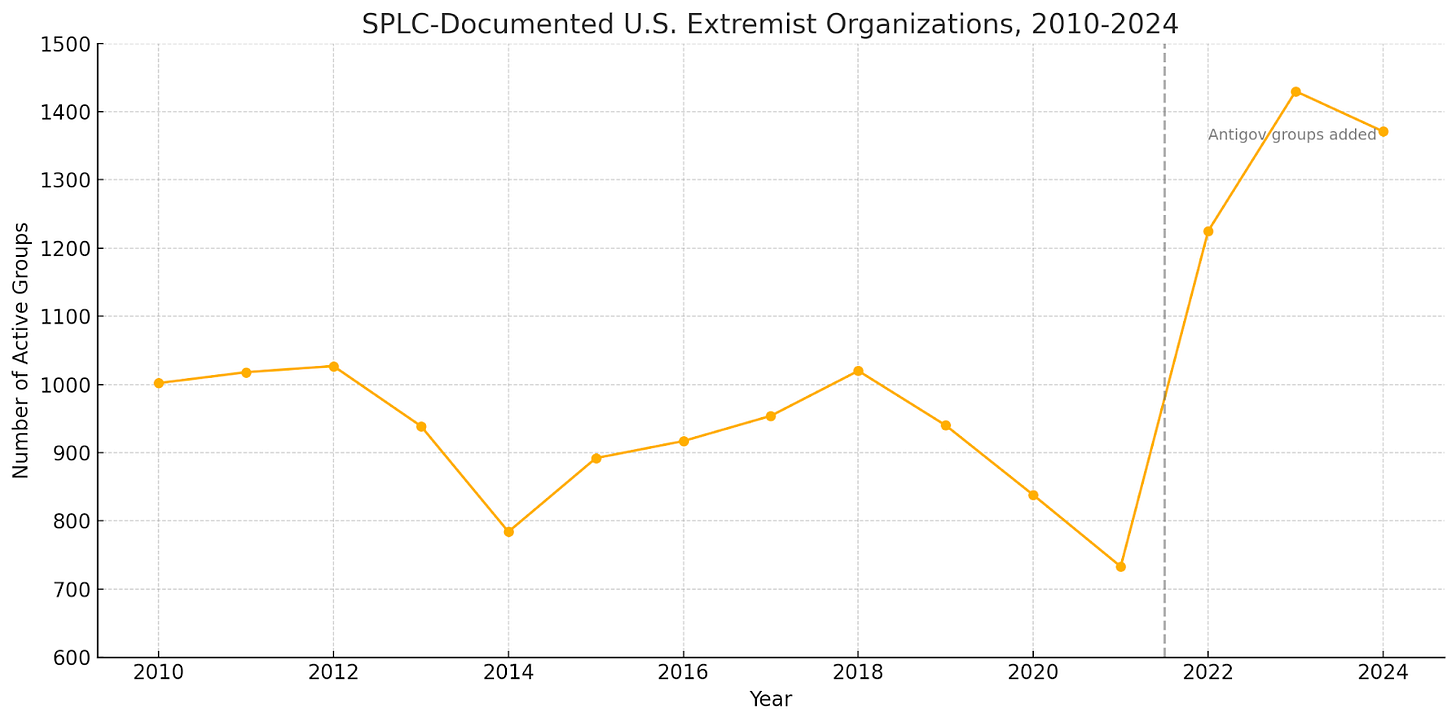
FBI hate crime data similarly shows a jump in 2021, but they also changed the data source they were using. Very frustrating indeed. The trends before and after this change look mostly flat.
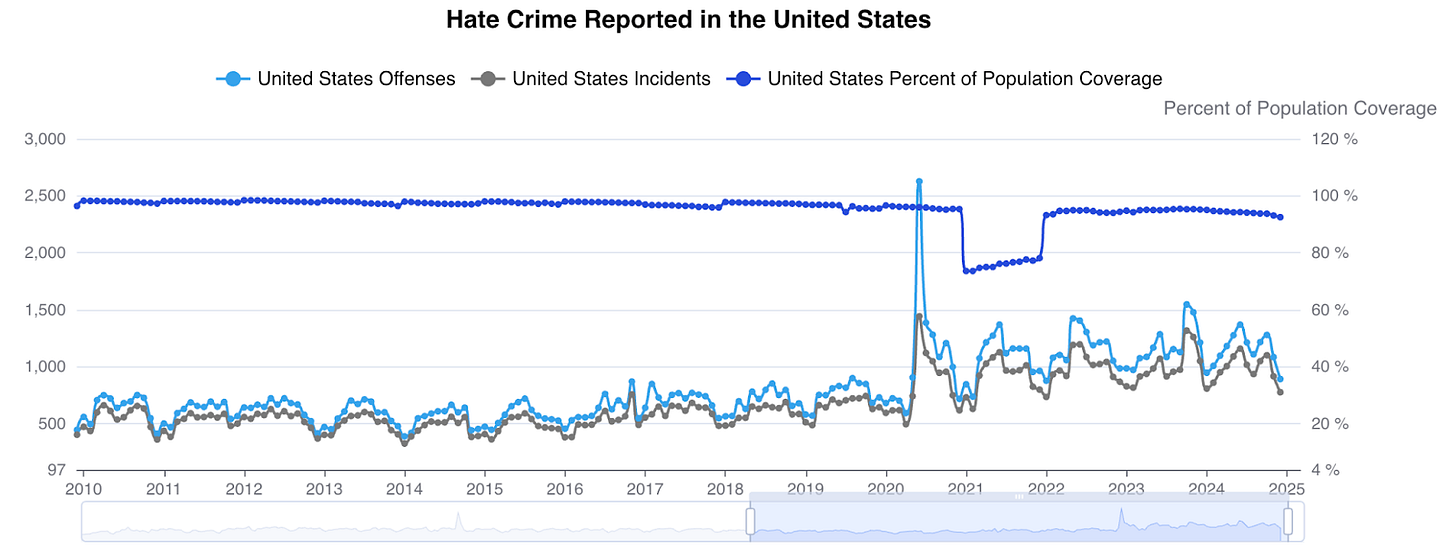
The number of people actually killed by domestic extremists, meanwhile, has been decreasing.
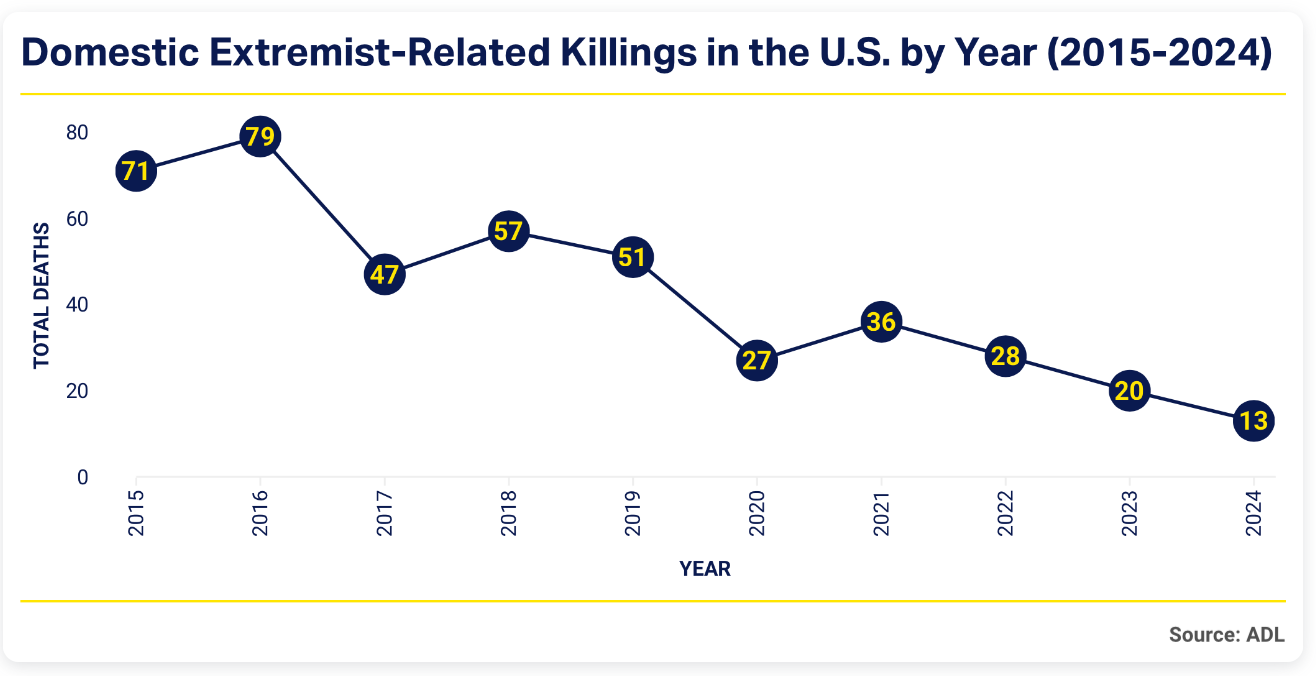
So are there more “fascists” or “nazis” or “extremists” than before? It’s not clear that there are – or even that we could tell if there were, given that definitions keep changing. That’s one problem with expanding these definitions. Another is that when a category gets too loose it eventually loses credibility. One source argues that we should include everyone who thinks the Jan 6 perpetrators should be pardoned, perhaps 20 million people. Some people call every Trump voter fascist, so that’s 77 million people.
This is called concept creep, and while it’s usually done in the name of justice, it might cause more harm than good:
The consequences of concept creep are more than semantic. If the same term is used to describe both extreme and everyday phenomena, it becomes more difficult to articulate the difference between them. …
Expanding concepts of harm also entails expanding the number of people classified as victims—and, by extension, as victimizers. This changes how we treat conflicts. In a disagreement between parties, we may seek mediation and compromise. If victimization has taken place, in contrast, the offending party warrants condemnation and punishment.
There is, of course, a similar problem with amplification of left extremism. The infamous Libs of Tiktok intentionally showcased only the most outrageous and cringe-worthy people. This sort of thing made unreasonable leftists seem far more common than they actually are, inflaming Red hostility.
However, just because there may not be more “fascists” doesn’t mean that far right ideas haven’t influenced government or culture. Trump himself fits comfortably in (pre-Trump!) definitions of a fascist. And in a 2024 article called How the Alt-Right Won, “Walt Bismark” describes how, even though the alt-right per se is no longer a coherent political force, it had wide effects on culture:
In 2016 we created a previously unimaginable space for once-stigmatized ideas in one of the fastest and most substantial Overton Window shifts in American history.
We intellectually colonized American conservatism, discrediting mainstream institutions and normalizing white identity politics to a degree inconceivable just a year earlier.
Today millions of MAGA boomers parrot our talking points without realizing it, while every intelligent young conservative is to some degree influenced by Alt Right ideology. This is the furthest thing from failure!
If you don’t like this type of politics, then it’s worth contesting! The problem is that, given the outsized media attention to extreme people, we can end up modeling our strategy on characters we’re unlikely to ever meet, and on dramatic fights that don’t represent typical encounters. Most people are persuadable, not irredeemable. Therefore most political problems require communication, not denunciation.
How SF’s mayor won everyone over
Daniel Lurie pulled off something that seems impossible in 2025 America: broad approval across the political spectrum. Six months into his term as San Francisco mayor, polling shows approval ratings of 78% among conservatives, 83% among liberals, and 85% among moderates. In polarized San Francisco – the city that gave us both the Summer of Love and the recall of progressive prosecutors – this is pretty remarkable.
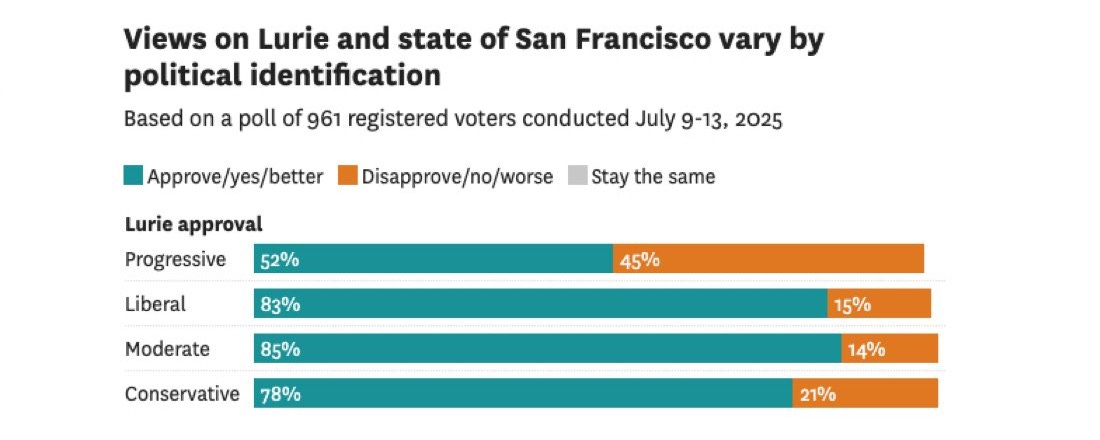
Lurie's secret isn't moderation but focus. He ran as a Democrat but barely mentions Trump. Instead, he talks relentlessly about safety, business, and getting things done. Crime is down 27% citywide and 45% in Union Square since he took office. Hotel bookings are up 60%. More importantly, he changed how the city operates. During his first month, Lurie got near-unanimous approval from the Board of Supervisors to expand his powers – not by forcing it through, but by asking, “Will you work with me?”
In an era when politicians succeed by picking fights, Lurie succeeded by focussing on problems everyone agrees exist rather than the ideological battles that dominate cable news. Critics argue his policies are performative – lots of police raids with few actual charges – but residents seem willing to give him the benefit of the doubt. A recent poll found 43% think the city is on the right track, double last year's number.
The multiracial Right keeps growing
We note this shift two years ago: people of color are moving Red, and it's not going away. Now an extensive New York Times article confirms what we've been tracking. This isn't about one election cycle, it's a phenomenon decades in the making driven by economic realities and monolithic perceptions of non-white voters that Democrats haven't addressed.
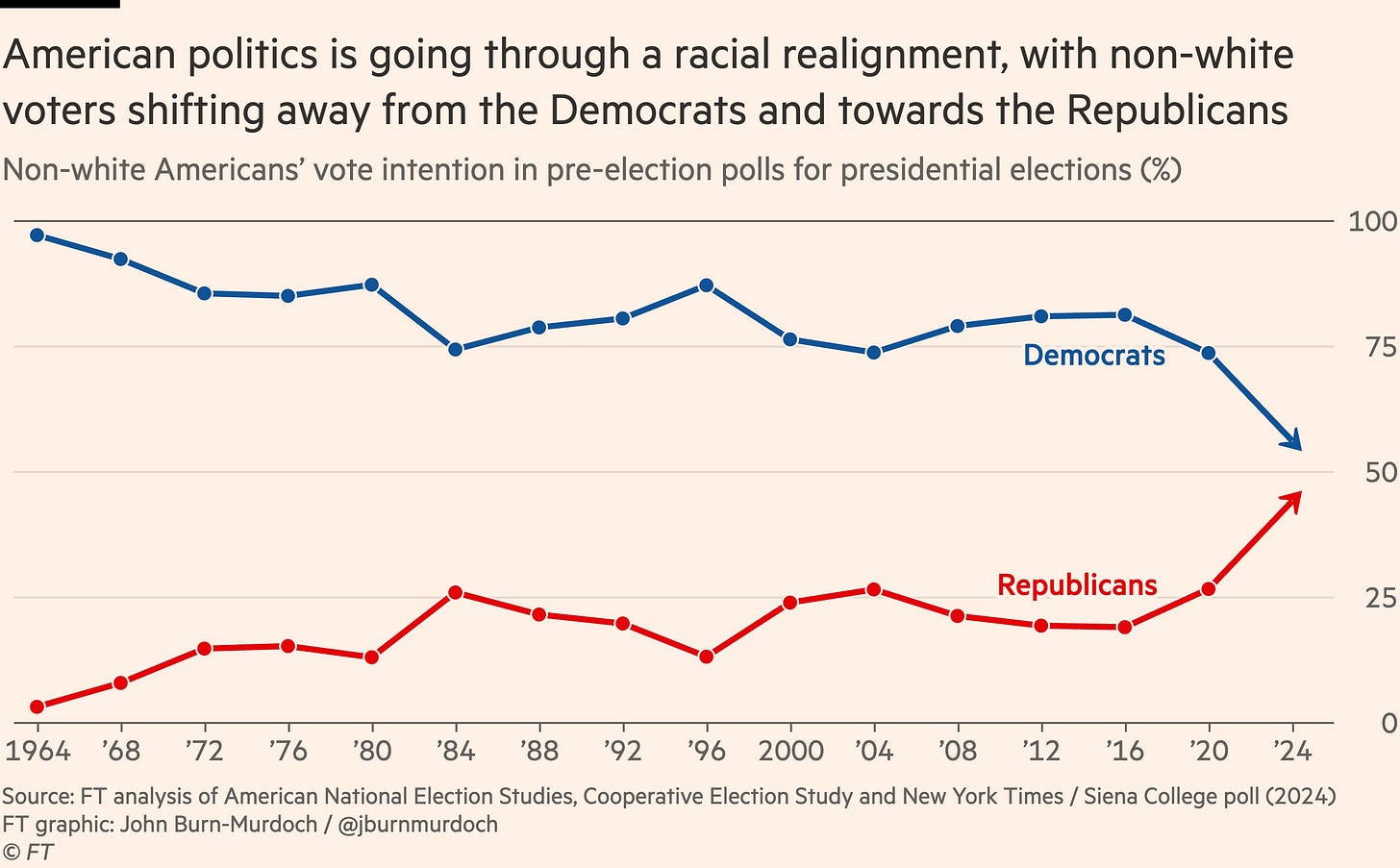
“A lot of Black people are not MAGA,” explains one interviewee from Milwaukee. “They're rejecting the Democrat leadership because of how they're running our communities. They need to take accountability for how they have mismanaged the Black communities.” When politicians offer fear-mongering about Trump instead of fixing local problems, loyalty becomes unaffordable. People aren't asking for different culture war positions – they want solutions to problems everyone agrees need fixing: crime, schools, economic security. The 2024 numbers made this shift undeniable: Trump won 48% of Hispanic voters, 40% of Asian Americans, and 21% of Black men.
The lack of buyer's remorse is striking. No one interviewed regretted their vote (as with Trump voters generally). These voters aren't embracing Trump's full agenda, but they're not defending institutions that failed them either. Their politics are "guided less by ideological rigidities and more by their aspirations to build lives of dignity for themselves and their communities." Until the Democrats understand that real world outcomes matter more than identity-based solidarity, expect these trends to continue.
Quote of the Week
spraying him with a spray bottle every time he ragebaits me
- @vixeias



